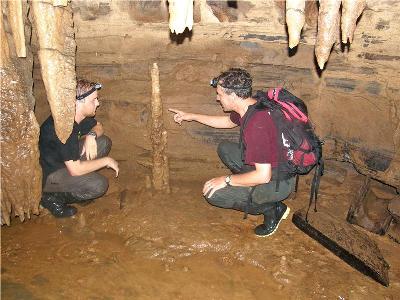Oct 3 2012
A new paper reveals that changes in the temperature of the Atlantic Ocean quickly translate into climate change in western Amazonia. North Atlantic forcing of Amazonian precipitation during the last ice age is co-authored by Dr Will Gosling of The Open University with the Florida Institute of Technology, and appears in this week’s Nature Geoscience.
 Professor Mark Bush (right) and undergraduate researcher Christopher LaDrew of the Florida Institute of Technology discuss a stalagmite in Santiago Cave, Ecuador.
Professor Mark Bush (right) and undergraduate researcher Christopher LaDrew of the Florida Institute of Technology discuss a stalagmite in Santiago Cave, Ecuador.
The research details chemical analysis of stalagmites recovered from a cave in Ecuadorean Amazonia that provides a record of changes in rainfall for almost the last 100,000 years. The data shows that Amazonia remained wet for that entire period, although there were rapid changes to drought and wet events. These rapid changes in rainfall correlated closely with changes in sea-surface temperature in the North Atlantic Ocean. For much of that time, cool ocean conditions induced wet events, whereas a warm ocean induced drought in the Amazon.
Professor Mark Bush, leader of the Florida Institute of Technology research group, said: “The exciting thing about the data is that it shows the quick response of the tropics to changes that took place in the Atlantic Ocean. A longstanding question in Amazonian ecology, the center of biodiversity, has been whether the ice ages were so dry that the area of rainforest contracted. The data suggests that Amazonia was as wet, or wetter, than present during the coldest period of the ice age."
Another unusual finding was that the changes that occurred were more rapid than previously reported, and that the Amazonian climate became decoupled from that of the Atlantic Ocean and the adjacent Andes during the coldest time of the last ice age, from about 40,000 to 17,000 years ago.
Dr Will Gosling, Lecturer in Earth Sciences at The Open University, said: “The reason for the more recent decoupling is not clear, but the data is of considerable importance. As we generate an understanding of the pace of past climate change, we can make more informed estimates of future changes.”
The climatic future of Amazonia is uncertain, but some models suggest that because of drying, most of the rainforest will be reduced to shrubby grasslands by 2050-2080 AD. Although the paleoclimatic record featured droughts in the past, none were of sufficient intensity to cause a loss of forest cover but, as Professor Bush states: "as the Atlantic Ocean warms, drought is inevitable for Amazonia, probably occurring on a scale that has not been evident in at least the last 100,000 years."
The research was funded by grants from the National Geographic Society (USA) and the National Science Foundation (USA), The Open University (UK) and the Natural Environment Research Council (UK).